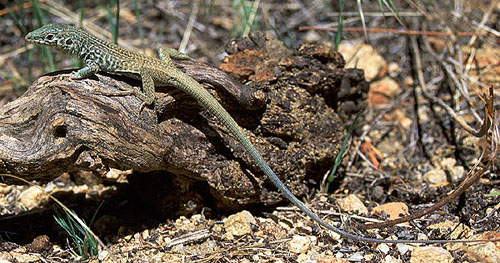Please see Parts I and II of this article for information on growing terrestrial and aquatic food plants for reptiles and amphibians.
Aquatic Invertebrates
 A startling variety of aquatic invertebrates will likely establish themselves in almost any body of standing water, be it a backyard pond or a container of water on a fire escape in the heart of a busy city (the adults of most aquatic insects are winged, and quickly locate new breeding sites). Ranging in size from tiny Daphnia to quite large dragonfly nymphs, all are fine food items for insectivorous herps, and make wonderful aquarium subjects as well.
A startling variety of aquatic invertebrates will likely establish themselves in almost any body of standing water, be it a backyard pond or a container of water on a fire escape in the heart of a busy city (the adults of most aquatic insects are winged, and quickly locate new breeding sites). Ranging in size from tiny Daphnia to quite large dragonfly nymphs, all are fine food items for insectivorous herps, and make wonderful aquarium subjects as well.
You can also use an outdoor pond to breed snails, guppies, crayfish and other useful food animals.
Terrestrial Invertebrates
Your reptile garden will, in addition, attract numerous terrestrial insects. All are interesting to observe and many can be collected to feed to your collection (a Bug Napper Insect Trap situated near a garden will provide a great nightly haul).
Flowering gardens are also important as feeding sites for pollinating insects, many of which are in serious decline. Over 80% of the world’s plants and 90% of US food crops rely upon insect pollinators.
A Bonus…Observing Garden Visitors
You are sure to come across some interesting finds, as invertebrate diversity, even in temperate areas, is astounding.
An acre of Pennsylvania soil, for example, can host 425 million individual invertebrates (including 2 million tasty earthworms!) and New York State is home to 4,125 species of beetles. Over 11,000 different types of moths may be found in the USA, and new species are constantly being uncovered in the most unlikely of places…be sure to check those captured in your Bug Napper carefully before popping them into a terrarium!
Further Reading
The leaf fall that gathers below your plants and trees will quickly become populated by an unbelievable assortment of millipedes, springtails, sow bugs, beetles and other creatures. Many of these, especially the smaller invertebrates, are vital foods for tiny poison frogs and other small herps. For information on collecting and using this free food source, please see my article on Leaf Litter Invertebrates.
Image referenced from Wikipedia and originally posted by Alvesgaspar
 That Reptile Blog – Reptile, Amphibian and Exotic Pet Care and Information
That Reptile Blog – Reptile, Amphibian and Exotic Pet Care and Information

 Reptiles hailing from desert and semi-desert habitats are often very sensitive to molds and fungi. Having evolved in unique, relatively pathogen-free environments, their immune systems are usually unable to adapt to attack by microorganisms commonly encountered in captivity.
Reptiles hailing from desert and semi-desert habitats are often very sensitive to molds and fungi. Having evolved in unique, relatively pathogen-free environments, their immune systems are usually unable to adapt to attack by microorganisms commonly encountered in captivity. Many of the substrates traditionally used for such creatures, including most types of sand, harbor molds and fungi when damp. Although not a problem (in limited-contact situations) for all desert animals, some are especially sensitive and quickly succumb to skin and respiratory infections.
Many of the substrates traditionally used for such creatures, including most types of sand, harbor molds and fungi when damp. Although not a problem (in limited-contact situations) for all desert animals, some are especially sensitive and quickly succumb to skin and respiratory infections. Live mealworms, waxworms or earthworms mixed into canned or pelleted food should encourage your turtle to take a bite. Earthworms are a box turtle favorite and a highly nutritious food in their own right…they can comprise 25% or so of the diet. An occasional pre-killed pink mouse is usually a great hit with box turtles, but is not a necessity.
Live mealworms, waxworms or earthworms mixed into canned or pelleted food should encourage your turtle to take a bite. Earthworms are a box turtle favorite and a highly nutritious food in their own right…they can comprise 25% or so of the diet. An occasional pre-killed pink mouse is usually a great hit with box turtles, but is not a necessity. Well, we’ve come a long way since the anole “sugar water days” (the recommended diet for green anoles sold at circuses in the 1960’s). Following is a mix that I and others have found useful for anoles, geckos, basilisks, skinks and others.
Well, we’ve come a long way since the anole “sugar water days” (the recommended diet for green anoles sold at circuses in the 1960’s). Following is a mix that I and others have found useful for anoles, geckos, basilisks, skinks and others.